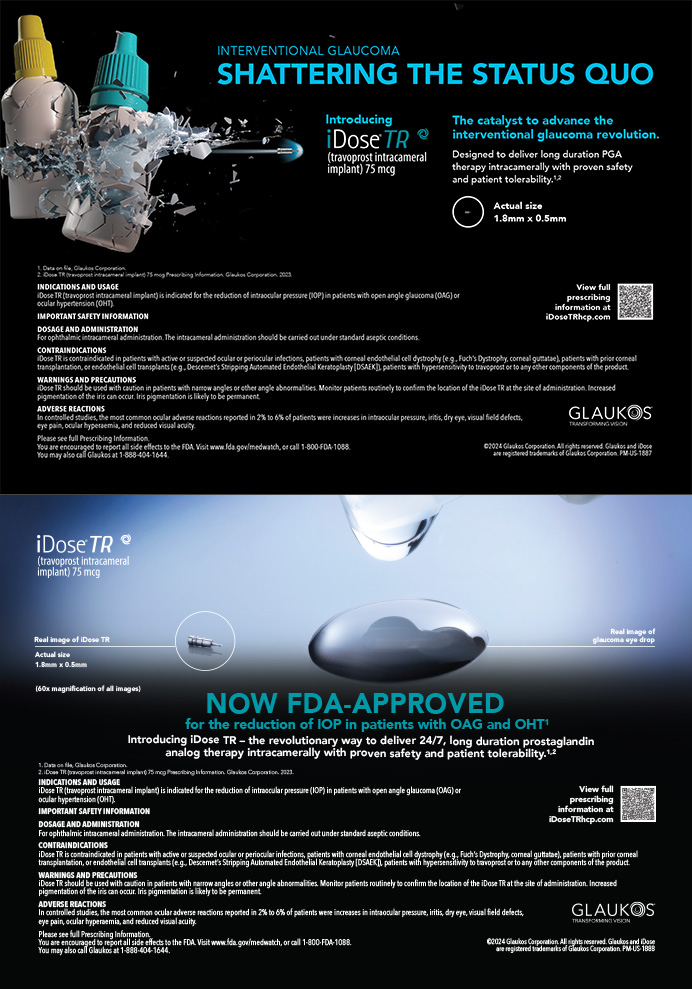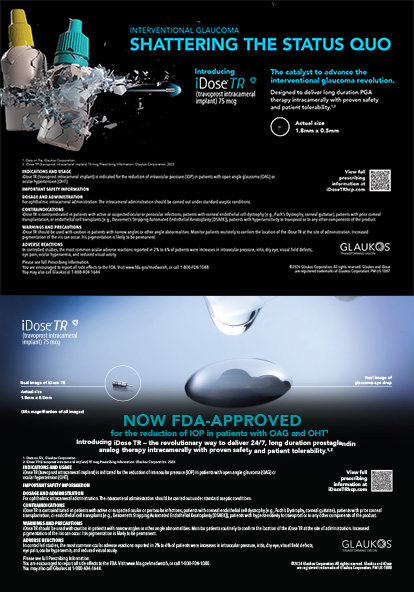In order to incorporate premium IOLs into a cataract practice successfully, the staff and prospective patients must first appreciate and embrace the lifestyle benefits afforded by this technology. The emphasis should be on seeing clearly without glasses (rather than on the technical details of the IOL subtypes). Most importantly, surgeons can only deliver on the promise of a new life without glasses after they have mastered a reliable system for astigmatic correction.
Inaccuracies in preoperative measurements or minor surgical variations can interfere with desired outcomes. Ophthalmologists often have no way to evaluate the refractive success of a procedure until weeks or months after surgery. New technology, however, is available in the form of an aberrometer designed to take intraoperative measurements. The ORange intraoperative wavefront aberrometer (WaveTec Vision, Aliso Viejo, CA) allows surgeons to check a patient's refraction during a procedure and to make adjustments while he or she is still on the operating table.
The ORange is currently being used in many US practices, including mine, with good surgical outcomes. Based on my experience, I consider it a valuable tool for cataract surgeons who seek to provide patients with the highest possible quality of vision.
THE BENEFITS OF INTRAOPERATIVE ABERROMETRY
Unlike a standard aberrometer, the ORange has been specifically designed for use during cataract surgery. Small enough to attach to the operating microscope, it can capture a refraction in just a few seconds. The unit then displays the measurements of sphere and cylinder on a computer screen located adjacent to the surgeon in the OR.
In addition to its ease of use, the ORange is able to capture data in some situations where a conventional aberrometer would be unable to achieve a reading. Because it uses Talbot-Moiré rather than Hartmann-Shack technology, the ORange has a wider dynamic range—from -15.00 to +25.00 D—and its ability to capture data in difficult eyes is more reliable than a standard aberrometer's. In addition to being able to measure many aphakic eyes, the ORange can also reliably capture a refraction through a multifocal IOL. I believe this is also due to a large dynamic range (ie, unaffected by highly disparate adjacent zones).
With these capabilities, the ORange has several potential applications. For patients with astigmatism, surgeons can use the device to ensure the proper alignment of a toric IOL or to check whether a limbal relaxing incision (LRI) has corrected the necessary amount of cylinder. Additionally, this aberrometer can confirm the refractive status of a post-LASIK eye immediately after the IOL's implantation, important information due to the potential inaccuracy of IOL power calculations in these cases. Similarly, the ORange can confirm the power and orientation of a phakic IOL.
Ophthalmologists' ability to correct residual refractive error during the initial surgical procedure may eliminate the need for subsequent intervention. Rather than undergo cataract surgery and wait 3 to 6 months before having LASIK to correct residual refractive error, patients now have a better chance of achieving their refractive target immediately following cataract surgery. By confirming that the IOL's power and orientation are correct intraoperatively, ophthalmologists also minimize the likelihood that the patient will need a subsequent IOL exchange or a second surgery to correct a misaligned IOL. All of this translates into much happier patients—an essential component for success.
CLINICAL EXPERIENCE
As the first surgeon to use the ORange routinely, I have employed it successfully during the past year for many of my cataract procedures, and I have found it to be a simple, streamlined tool for performing real-time wavefront aberrometry. After a modest learning curve, I have had little trouble incorporating the device into my surgical routine.
Typically, I use the ORange to check the refraction at the conclusion of surgery, just before I remove the lid speculum. To capture the reading, I simply turn off the white light from the operating microscope, request that the patient look at the aberrometer's target light, and check the results. If the desired refractive outcome has not been achieved, I perform additional LRIs as needed or even exchange IOLs (on rare occasions).
PEARLS FOR USE
Ocular Edema
When comparing an intraoperative reading obtained with the ORange to subsequent readings taken days or weeks following surgery, some discrepancy may occur due to early postoperative ocular edema. Although swelling is not typically present during surgery, it often appears postoperatively and can transiently alter the eye's refractive status. Thus, the intraoperative reading may differ from the refraction obtained in the days or weeks following the surgery, but it will agree with the final refractive outcome.
LRIs
Although I find the ORange system indispensable for measuring residual refractive error and guiding real-time enhancements, it cannot perform the LRI for me. In an era when technology enables surgeons to routinely peel membranes off the retina, I believe it is inexcusable to implant a multifocal IOL and shy away from performing a proper LRI to simultaneously reduce or eliminate a patient's astigmatism.
The three most important variables in achieving success with LRIs are their location, depth, and length. One can establish where to incise the cornea preoperatively and confirm the location intraoperatively (using the corneal light reflex as a reference point for centration). Proper depth can best be achieved by using a Genesis (KMI Surgical, Downingtown, PA) or a combined-technique diamond. The selection of length ensues from the surgeon's knowledge of desired correction and the use of proper nomograms.
MEETING PREMIUM IOL PATIENTS' EXPECTATIONS
As new technology continues to raise patients' expectations, ophthalmologists must refine their surgical techniques to provide the maximum benefit possible with today's premium IOLs. In my opinion, the ORange may represent a significant step forward, because it determines whether the desired refractive outcome has been achieved before patients leave the OR.
In addition, I find that the ORange aberrometer can be a selling point when discussing with patients the benefits of premium IOL surgery. They recognize that I am offering not only the most advanced IOLs but also state-of-the-art surgical equipment that provides a benefit that they can easily understand.
THE BOTTOM LINE
The ORange is now commercially available. Overall, I believe that the advantage of coupling wavefront technology with cataract surgery may be even greater than in refractive surgery. It allows surgeons to perform intraoperative refractions, even in aphakic eyes or eyes with multifocal IOLs. With this information, surgeons can adjust the IOL's alignment and the configuration of LRIs, and they can confirm that the correctly powered IOL has been implanted.
This tool therefore helps ophthalmologists achieve excellent refractive outcomes following cataract surgery, resulting in better visual outcomes and a better experience for patients.
Kerry K. Assil, MD, is a specialist in cataract and refractive surgery at the Assil Eye Institute in Beverly Hills and Santa Monica, California. He is a paid consultant to WaveTec Vision. Dr. Assil may be reached at (310) 453-8911; kassil@assileye.com.


